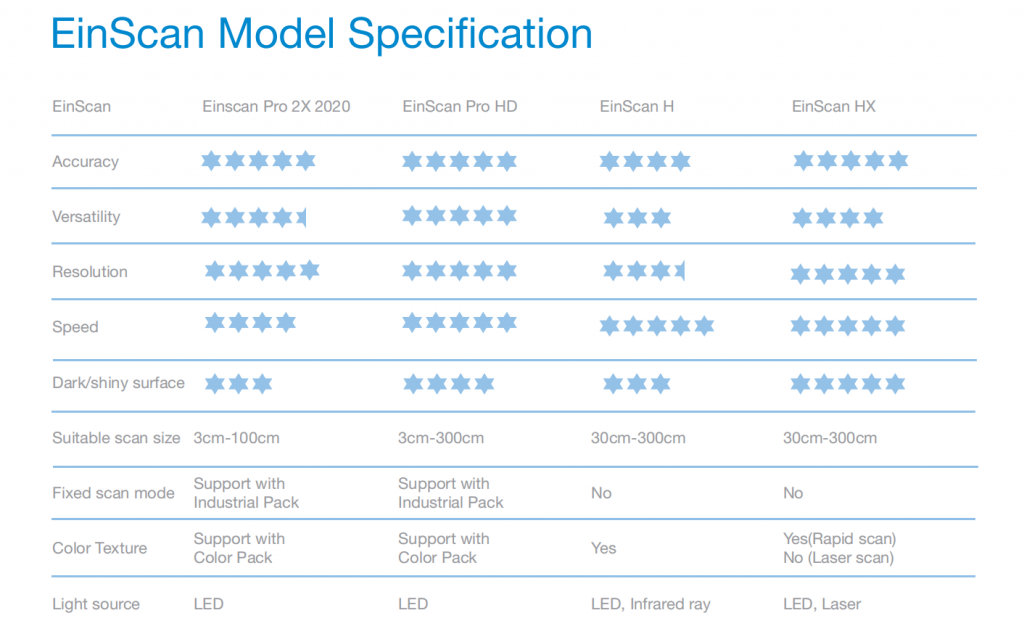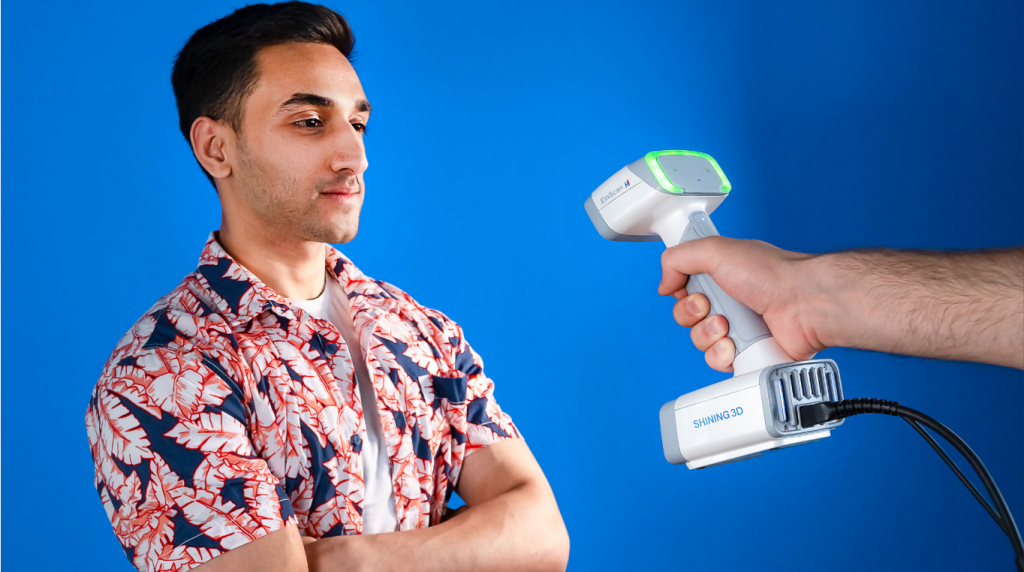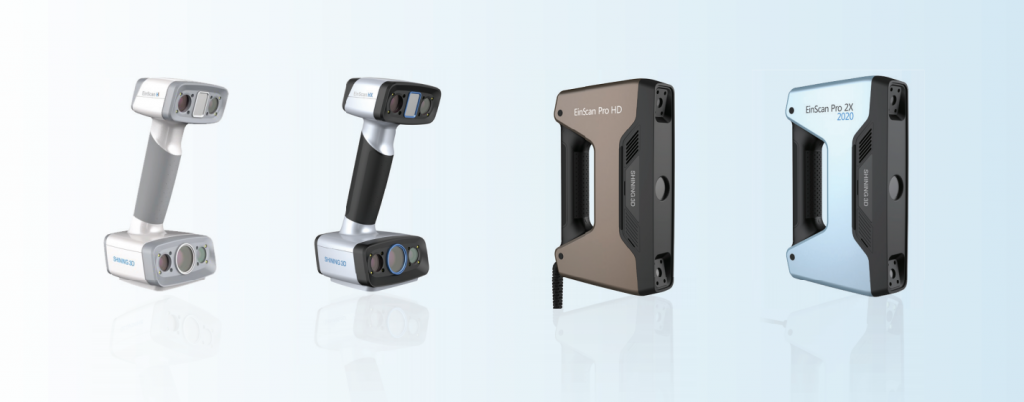There are many reasons why handheld 3D scanners occupy a large share of the 3D scanning market. Portable, versatile, and accurate enough for many professional applications, handheld scanners offer advantages over static solutions like desktop scanners and photogrammetry systems.
Perhaps the biggest of those advantages is versatility. Because handheld 3D scanners can be moved to different positions around the scanned object, they can be used to scan large objects, hard-to-reach objects, and even objects located outdoors. And although these benefits come at the expense of a certain degree of accuracy — the manual movement involved in handheld scanning can have an adverse effect on point cloud data — many users find handheld scanning to be the ideal option for their professional needs.
Not all handheld 3D scanners work in the same way, however. In today’s market, the majority of scanners use structured light technology. These scanners project a pattern of light onto the scanned object and use cameras to see how these lines of light deform upon the object’s surface. Measuring these deformations allows the scanner to understand the 3D shape of the object. Other scanners, however, use laser scanning technology, which involves shining a laser onto the object and using sensors to measure the distance between scanner and object.
Table of Contents
What to consider when choosing a handheld 3D scanner
The wide range of handheld 3D scanners on the market gives consumers a lot of options, but it also makes it harder to identify the most suitable product for their needs. When choosing a handheld 3D scanner, buyers need to consider many different factors, making an assessment of their options based on what the scanner will be used for. Needless to say, the right 3D scanner for a healthcare professional may not be the right 3D scanner for a mechanical engineer.
One of the most important specifications of a 3D scanner is its resolution, which can be defined as the distance between data points in a point cloud. Although not the be-all and end-all of scanning, many customers will choose their 3D scanner based on its resolution capabilities: high-resolution scanning paints a truer, sharper picture of the scanned object than low-resolution scanning, and is especially useful for small objects with fine features.
That being said, many scanning applications do not require high resolution in order to be practical. For instance, when scanning large objects like furniture and vehicles, users might be more concerned with scanning speed than resolution. Usually expressed in points captured per second, scan speed is equally valuable for applications like human body scanning, where the scanned object cannot remain stationary for too long, and for time-sensitive projects like outdoor scanning during adverse weather conditions.
Another factor to consider when buying a handheld 3D scanner is the scanner’s accuracy. Accuracy (not to be confused with precision) can be defined as the closeness of a scanned measurement to the true, real-life measurement. Accuracy is critical in scanning applications like quality inspection and reverse engineering, where an inaccuracy of just a fraction of a millimeter could cause problems down the line.
When choosing a 3D scanner, some factors are harder to quantify but are nonetheless equally important. A scanner’s versatility, for instance, can be loosely defined by its range of scanning resolutions, speeds, fields of view, and scanning modes. A more versatile scanner can be used for a broader range of applications and might suit buyers who need a scanner for more than one particular task.
Finally, a key consideration for anyone looking to buy 3D scanners is the price. More expensive scanners typically offer better resolution, speed, and accuracy, but buyers have to consider the most realistic options for their budget.

Priority: Versatile 3D scanning
When versatility is a high priority, buyers should look for a 3D scanner with portability, adjustable parameters, and multiple scanning modes. But for a scanner to be equally capable of scanning large and small objects, it must offer good resolution and scan speed as well.
One handheld scanner that is built for a broad range of scanning applications is the EinScan Pro HD. Modular and multifunctional, the Pro HD offers different scanning modes for different tasks:
1.Handheld HD Mode, capable of achieving a 0.2 mm point-to-point distance (resolution), captures the finest details with maximum clarity;
2.Handheld Rapid Mode processes up to 30 frames per second;
3.While Fixed Scan Mode (optional add-on) allows the Pro HD to be used as a static scanner for improved accuracy.
Another useful feature of the Pro HD is its projection algorithm, which can capture a range of textures, including hard-to-scan surfaces such as shiny metal or very dark-colored surfaces.
Due to its range of modes, features, and optional add-ons, the Pro HD is as suited to industrial reverse engineering as it is to capturing sculptures and historical artifacts.
Priority: 3D scanning small to medium-size objects
Some users don’t need their 3D scanner to perform a wide range of tasks. For those scanning items like archaeological finds, pieces of jewelry, healthcare models, or intricate mechanical components, the main priority for their 3D scanner is the ability to capture small or medium-size objects at high resolution. Such a scanner needs both high-resolution optical capabilities and a field of view suitable for small objects — usually achieved by having the cameras positioned close together.
The EinScan Pro 2X 2020 is a device purpose-built for scanning small and medium-size objects. With a suitable scan size of 3–100 cm and a minimum point distance of 0.2 mm, the Pro 2X 2020 boasts the fine-detail scanning capabilities of the Pro HD but in a more affordable package. Other useful features include color scanning (optional add-on) and various alignment modes.
For users who don’t need the ultra-fast or large-scale scanning ability of the Pro HD, the Pro 2X 2020 is a standout option.
Priority: 3D scanning reflective or dark surfaces
Structured light scanning is a fast and accurate technology suitable for many professional uses. However, the technology can run into difficulties when scanning surfaces that are reflective, transparent, or very dark. Such surfaces can distort the projected light patterns, which means the cameras are unable to collect useful information about the geometry of the scanned object.
For users who regularly need to scan dark or reflective surfaces — those working with cast metal, for instance — an alternative to structured light scanning may be required.
A suitable option for scanning dark and reflective surfaces is the EinScan HX. Equipped with both LED and laser scanning hardware, the hybrid HX offers a set of capabilities entirely different to those of the Pro HD and Pro 2X 2020. Its laser scanning technology provides a very high level of accuracy (0.04 mm) and resolution (minimum point distance of 0.05 mm), and the device can capture the most difficult textures and surfaces with good results.
Suitable professional applications of the EinScan HX include reverse engineering and industrial metrology.
Priority: 3D scanning the human body

3D scanning the human body has proven to be a challenging task for developers and users of scanning technology. Firstly, it is difficult for a person to remain entirely motionless for the duration of a scan, which can cause irregularities in the scan data. Secondly, human hair — with its unusual texture, shininess, and range of colors — is notoriously difficult to scan.
In many situations, large fixed scanners with multiple cameras or revolving platters are used for body scanning, but handheld devices can also deliver good results. One 3D scanner in this category is the EinScan H, a full-color handheld scanner that uses both LED light projection and an infrared ray to capture bodies and other objects at high speed.
The EinScan H is packed with features that facilitate easy body scanning. For instance, the infrared ray — deployed during Face Scan Mode — causes less eye discomfort than a sequence of bright, flashing lights. Meanwhile, an optimized, non-rigid alignment algorithm during Body Scan Mode allows for smooth capture of the body even when it makes slight movements.
These features, coupled with a scan speed of 1.2 million points per second, make the H suitable for 3D modeling, VR, and gaming applications.
How to choose the right handheld 3D scanner

Choosing the right handheld 3D scanner involves two key steps. The first is to identify potential end uses for the scanner and determine the features and specifications that those cases require. For instance, if you plan to capture small, intricate parts, you will need a high-resolution scanner; if you plan to carry out body scanning, you will need color 3D scanning capabilities.
The second step in choosing a handheld 3D scanner is deciding whether any compromises must be made for the sake of keeping within a given budget. If a feature is desirable but not strictly necessary for the chosen application, then it may be worth going with a more low-cost solution that lacks additional features.
Potential future uses for the scanner should also be factored into the calculation (as should the scanner’s expected lifespan and trade-in/resale value). A higher-grade device may be worth the extra investment if, in the future, new applications arise for which its additional features can be exploited. For example, a company’s current workflow might involve capturing scans of miniature nylon components — a task suitable for a low-cost scanner like the EinScan Pro 2X 2020. But its scope of operation may later include highly reflective metal parts, for which a scanner like the EinScan HX would be better suited.
Finally, buying a handheld 3D scanner should involve research into the hardware manufacturer’s reputation. Shining 3D’s EinScan brand of 3D scanners is used by professionals across many industries all over the world. So whichever handheld scanner you choose, you’ll be getting a product that is proven to operate at the highest level.





